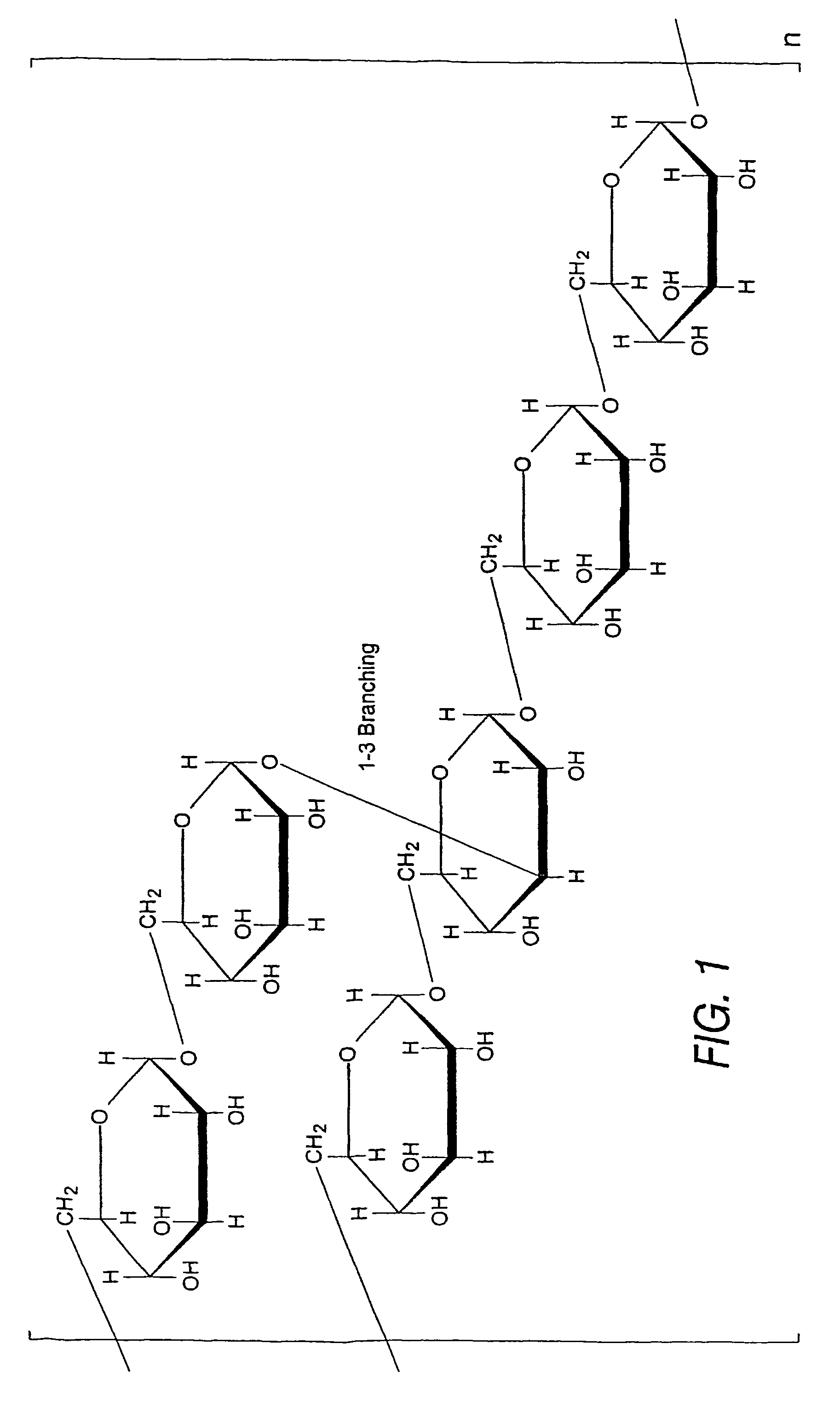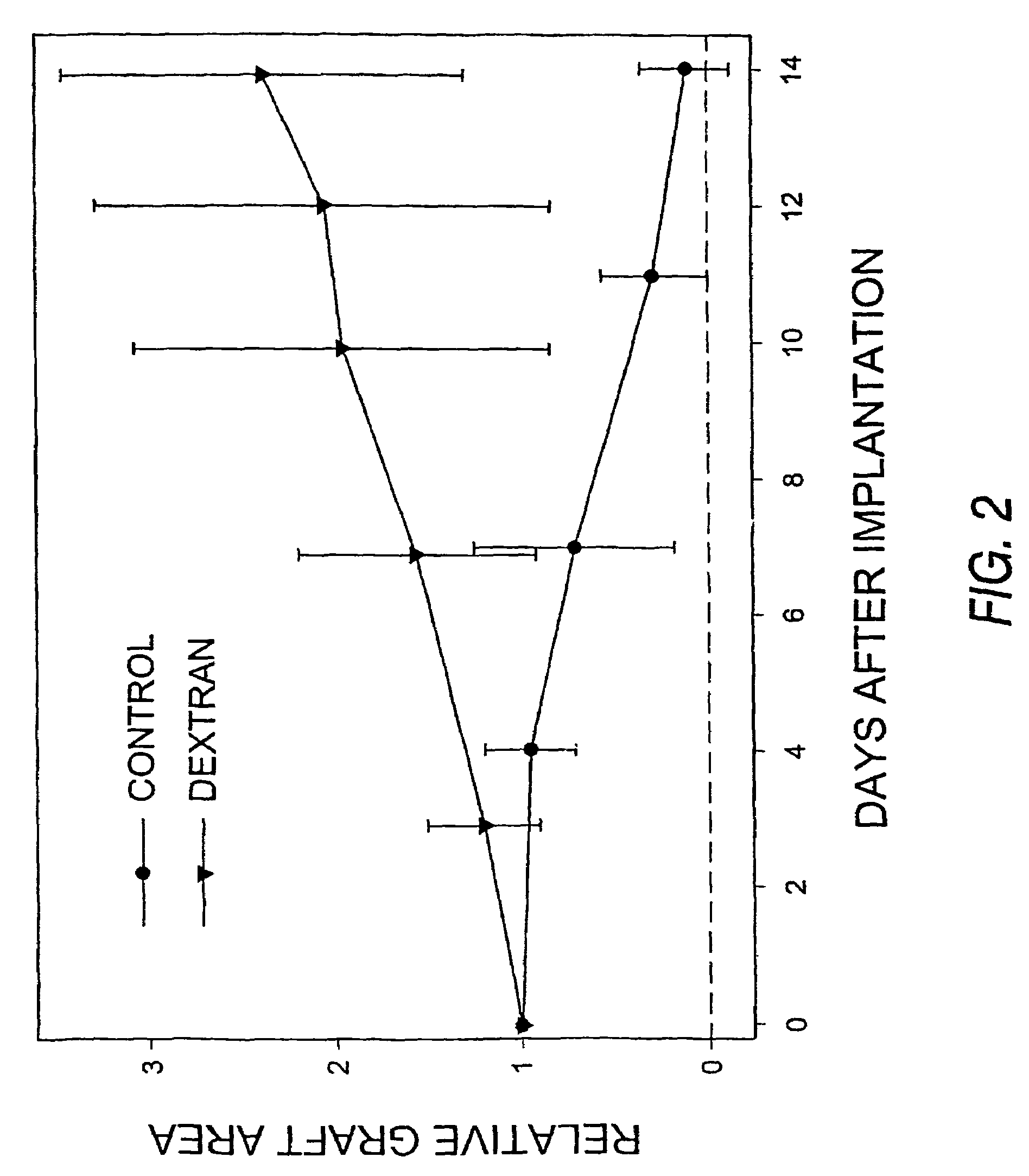Inhibition of antigen presentation with poorly catabolized polymers
a technology of catabolization and antigen presentation, applied in the field of immunosuppression, can solve the problems of recipient sensitivity to other disorders, cell lysis and destruction of transplanted cells, and typical failure of grafts
- Summary
- Abstract
- Description
- Claims
- Application Information
AI Technical Summary
Benefits of technology
Problems solved by technology
Method used
Image
Examples
example 1
Inhibition of Xenograft Tissue Rejection Through Pre-Treatment With a Dextran Polymer
[0035]Dextran, derived from Leuconostoc mesenteroides, strain B512 (average Molecular Weight 500,000 Da) was used in the following studies. A dextran solution, suitable for administration to animals, was made by dissolving solid dextran in sterile deionized water (dH2O) to a final concentration of 10%.
[0036]For cellular implants into mice, human HT1080 spheroids expressing green fluorescent protein were used. These spheroids were prepared using the following method. Histone H2B-GFP, prepared as previously described (Kanda, et al., Curr. Biol. 26:377-85 (1998)), was subcloned into the LXRN retroviral vector (Clontech, Palo Alto Calif.). The resultant H2B-GFP LXRN vector was cotransfected with VSVG into GP-293 cells (Clontech) and viral supernatants harvested 48 hours post transfection. Retroviral supernatants were concentrated by centrifugation at 50,000 g and stored at −80° C. until use. HT1080 cell...
example 2
Effects of the Route of Administration of the Dextran Polymer on Xenograft Survival
[0041]To examine the temporal and spatial dependence of the dextran polymer on graft survival, dextran was administered intraperitoneally (i.p.) verses intraveneously (i.v.). The methodology of Example 1 was used with the following modifications. C57B1 / 6 mice having implanted titanium chambers were divided into four groups. The first group was designated as the control group and received no treatment. The second group received 200 μl i.p. injections of the sterile 10% dextran solution every 24 hours beginning two days prior to spheroid implantation. On the day of spheroid implantation and thereafter, the injection volume was reduced to 100 μl. The third group of mice received 100 μl i.v. injections of the sterile 10% dextran solution every 24 hours beginning four days after spheroid implantation. The fourth group (designated the Re-implant group) was comprised of mice that had rejected a spheroid xeno...
example 3
The Effect of Dextran Uptake On Antigen Presenting Cells
[0044]The uptake of dextran by APCs was shown by injecting mice with fluorescein isothiocyanate (FITC) labeled dextran then visualizing tissue sections by fluorescent microscopy. C57 / B16 mice were divided into two groups. Mice in the first group received a 200 μl i.v. injection of a 2% FITC labeled dextran solution (average MW of dextran 500,000 Da). Twenty-four hours later, the animals were sacrificed and organ sections were whole mounted and imaged using fluorescent microscopy. Mice in the second group received a 200 μl i.v. injection of an unlabeled 10% dextran solution one daily for 48 hours. At the end of the 48 hour period, the mice were given a 200 μl i.v. injection of the 2% FITC labeled dextran solution. Twenty-four hours later, these animals were subjected to the same treatment as mice in the first group.
[0045]Analysis of the tissues of mice in the first group revealed macrophage-like cells taking up the labeled dextr...
PUM
| Property | Measurement | Unit |
|---|---|---|
| average molecular weight | aaaaa | aaaaa |
| average Molecular Weight | aaaaa | aaaaa |
| body weight | aaaaa | aaaaa |
Abstract
Description
Claims
Application Information
 Login to View More
Login to View More - R&D
- Intellectual Property
- Life Sciences
- Materials
- Tech Scout
- Unparalleled Data Quality
- Higher Quality Content
- 60% Fewer Hallucinations
Browse by: Latest US Patents, China's latest patents, Technical Efficacy Thesaurus, Application Domain, Technology Topic, Popular Technical Reports.
© 2025 PatSnap. All rights reserved.Legal|Privacy policy|Modern Slavery Act Transparency Statement|Sitemap|About US| Contact US: help@patsnap.com



